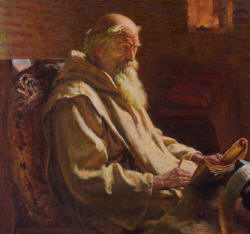
The Historical Works Of Venerable Bede
CHAPTER XIX
OF ALEXANDRIA, THE RIVER NILE, AND THE CHURCH IN WHICH MARK THE EVANGELIST IS BURIED
ALEXANDRIA extends to a great length from east to west. On the south it is bounded by the mouths of the Nile, and on the north by the Lake Mareotis. Its port is more difficult than the others, and has a resemblance to the human body; for in its head it is sufficiently ample, but when there are waves it is too narrow, because it admits the tide of the sea, together with such ships as run into the port to recover themselves and refit. But when one has passed the narrow neck and mouth of the harbour, the sea, still following the likeness of the human body, spreads itself far and wide. On its right hand side is a small port, in which is the Pharos, a large tower, which is every night lighted up with torches, lest sailors might mistake their way in the dark and dash against the rocks, in their attempt to find the entrance, particularly as this is much impeded and disturbed by the waves dashing to and fro. The port, however, is always calm, and in magnitude about thirty furlongs. Towards Egypt, as one enters the city, there is a large church on the right, in which reposes St. Mark the Evangelist. The body is buried in the eastern part of the church before the altar, with a monument over it of squared marble. Along the Nile the Egyptians are in the habit of constructing numerous mounds to prevent the irruption of the water, which, if the mounds were to be broken down by the neglect of the guardians, would not irrigate, but inundate and destroy the lands beneath. The Egyptians who inhabit the plains over the canals, make their houses by laying transverse planks thereon.

 Support Site Improvements
Support Site Improvements